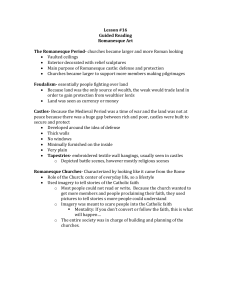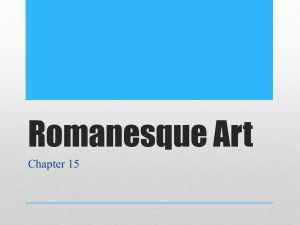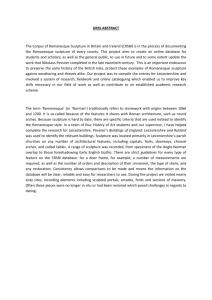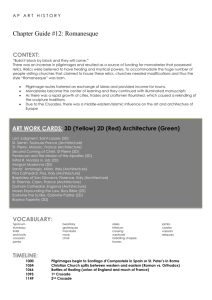The Middle Ages in Western Europe
advertisement
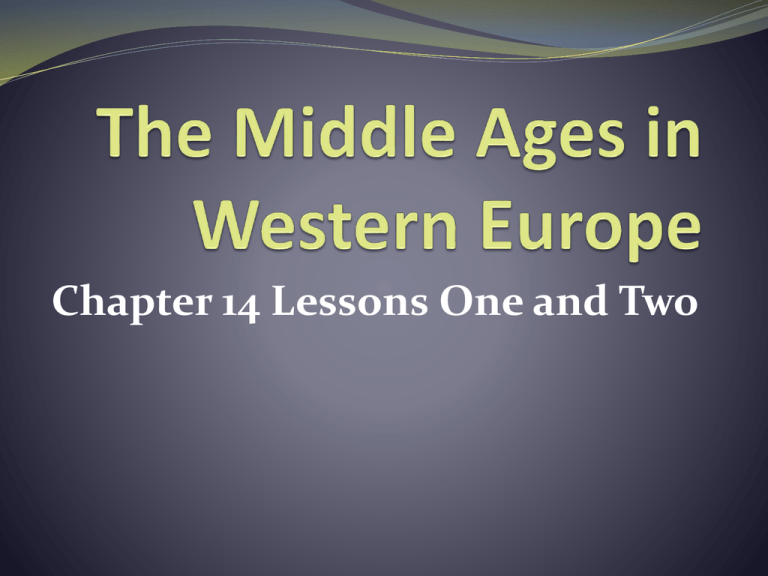
Chapter 14 Lessons One and Two The Middle Ages in Western Europe: Early Middle Ages: Early Christian: 200 AD – 550 Dark Ages: 550-750 Carolingian and Ottonian: 750-1000 Romanesque: 1000-1150 Gothic: High Gothic: 1150-1400 Late Gothic: 1300-1500 Dark Ages a.k.a. The Age of Faith The Medieval Church Devils and Division Visions of Heaven and Hell Division of clergy into secular and cloistered Carolingian and Ottonian: Charlemagne's Empire Charlemagne: The Roman Ideal "Charles the Great" – semiliterate All of Western part of the old Roman Empire except Britain, Spain, southern Italy, and Africa. Revived art and learning Welcomed Jewish immigration and trade throughout the Mediterranean Art of the Early Middle Ages Painting Tangible expression of faith Made the rites of the church more vivid Illustrate Church Doctrine and history Art of the Early Middle Ages Illuminated Manuscripts Change to codex format from scrolls Influence of Irish art on GrecoRoman prototypes flat, ornamental, precisely rendered, highlight & shadow, few colors, figures outlined Art of the Early Middle Ages Sculpture A minor or small scale art Prohibition of graven images by Old Testament Gero Crucifix is a contrast to Christus Rex type Suffering Christ vs. Risen and Glorious Christ Gero Crucifix Christus Rex Romanesque : Castles Purpose: Defense Eliminated possibility of windows Three styles: Motte-and-bailey: a high mound (motte) of earth on which sat a wooden tower overlooking a courtyard (bailey). Both the Motte and bailey surrounded by a moat. Corfe Castle Restormel Castle Romanesque : Castles (cont.) Stone keep: 3 or 4-story story castle. Square with square towers at each corner and a carefully defended entrance at ground level Romanesque : Castles (cont.) Concentric Castle: two rings of walls for protection. Inner wall higher than outer wall Romanesque : Castles (cont.) Layout: Thick walls with narrow slits for archers Steep Stairs, dark and narrow passageways Drafty rooms sparsely furnished Romanesque: Castles (cont.) Layout (cont.): Tapestries sometimes adorned walls to keep dampness out. Tapestries: textile wall hangings that were woven, painted, or embroidered with colorful scenes Romanesque: Churches At the center of EVERY town Exemplified the power and wealth of the Church Richly decorated stone Roman cross ground plan, side aisles, larger size (carryover of Carolingian design) Bays Ambulatory Apse Nave Aisle Aisle Aisle Aisle Transept Romanesque: Churches (cont.) Size of Churches increased to accommodate Pilgrimages Nave and Transept extended Added an aisle on each side of the Nave Added ambulatory walking space curving around the main altar Romanesque: Churches (cont.) Added altars in small curved chapels built along the transept and ambulatory To accommodate the necessary additional priests Romanesque: Churches (cont.) Stone vaulted roof used a system of vaults, transverse arches and bays to create an open, high central space transverse arch: pointed arches bay: any of a number of similar major vertical divisions of a large interior, a.k.a. a wall Revival of Sculpture and Painting Relief Sculpture Purpose: to teach the faith Capital decoration Biblical scenes, human figures, birds, animals Revival of Sculpture and Painting (cont.) Tympanum: half-round panel that fills the space between the lintel and the arch over a doorway of the church Large figure at center, with smaller figures on either side. The Last Judgment was a popular theme Revival of Sculpture and Painting (cont.) Paintings Church Wall paintings and Manuscript Illumination Common Features Purpose: create easy-tounderstand religious symbols Reality NOT important Flat, colorful shapes, bold use of line
